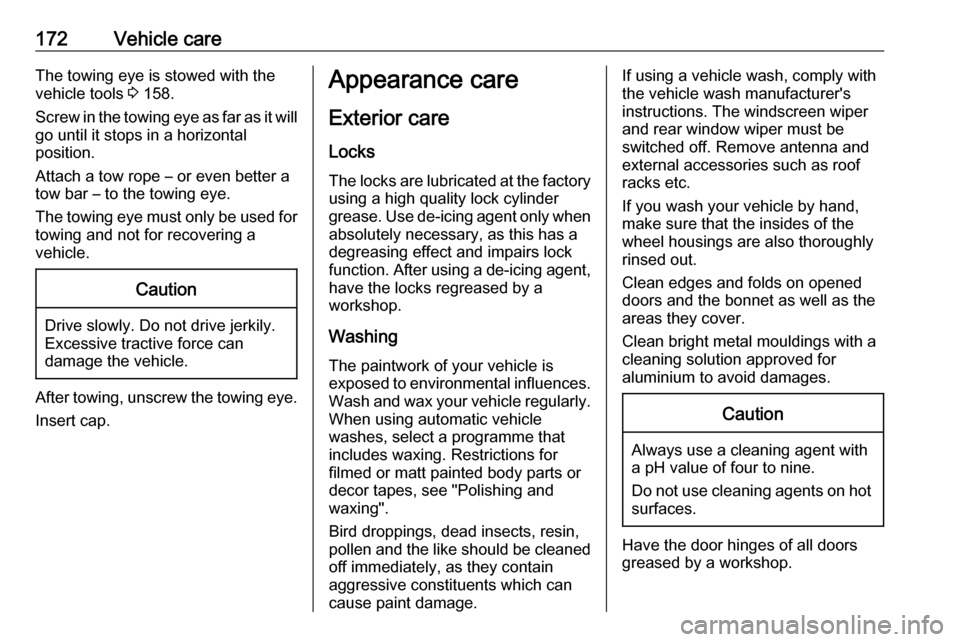ABS VAUXHALL COMBO D 2017.5 Owner's Manual
[x] Cancel search | Manufacturer: VAUXHALL, Model Year: 2017.5, Model line: COMBO D, Model: VAUXHALL COMBO D 2017.5Pages: 201, PDF Size: 4.7 MB
Page 70 of 201

68Instruments and controlsInstruments and
controlsControls ....................................... 69
Steering wheel adjustment ........69
Steering wheel controls .............69
Horn ........................................... 69
Windscreen wiper/washer .........70
Rear window wiper/washer .......70
Headlamp washer .....................71
Outside temperature ..................71
Clock ......................................... 71
Power outlets ............................. 73
Cigarette lighter ......................... 74
Ashtrays .................................... 74
Warning lights, gauges and indi‐ cators ........................................... 75
Instrument cluster ......................75
Speedometer ............................. 75
Odometer .................................. 75
Trip odometer ............................ 75
Tachometer ............................... 75
Fuel gauge ................................ 76
Fuel selector .............................. 76
Engine coolant temperature gauge ....................................... 77
Service display .......................... 77Transmission display .................78
Control indicators ......................78
Generic warning ........................80
Turn signal ................................. 81
Seat belt reminder .....................81
Airbag and belt tensioners .........81
Airbag deactivation ....................82
Charging system .......................82
Malfunction indicator light ..........82
Brake system ............................. 83
Brake pad wear ......................... 83
Antilock brake system (ABS) .....83
Transmission ............................. 83
Gear shifting .............................. 84
Hill start assist ........................... 84
Ultrasonic parking assist ...........84
Electronic Stability Control ........84
Engine coolant temperature ......85
Preheating ................................. 85
Diesel particle filter ....................85
Tyre pressure monitoring system ...................................... 86
Engine oil pressure ....................86
Change engine oil .....................87
Low engine oil level ...................87
Low fuel ..................................... 87
Drain fuel filter ........................... 88
Immobiliser ................................ 88
Stop-start system ......................88
Exterior light .............................. 88High beam................................. 88
Fog light ..................................... 89
Rear fog light ............................. 89
Cruise control ............................ 89
Door open .................................. 89
Information displays .....................89
Driver Information Centre ..........89
Vehicle messages ........................94
Warning chimes .........................94
Fuel system messages ..............95
Trip computer ............................... 95
Page 82 of 201

80Instruments and controlsControl indicator in the roof
console
Airbag deactivation 3 52, 3 82.
Overview
9Generic warning 3 80OTurn signal 3 81XSeat belt reminder 3 81vAirbag and belt tensioners
3 81*Airbag deactivation 3 82pCharging system 3 82ZMalfunction indicator light
3 82RBrake system 3 83FBrake pad wear 3 83uAntilock brake system (ABS)
3 83sTransmission 3 83[ ÒGear shifting 3 84ZHill start assist 3 84rUltrasonic parking assist
3 84RElectronic Stability Control
3 84$Engine coolant temperature
3 85!Preheating 3 85%Diesel particle filter 3 85wTyre pressure monitoring
system 3 86IEngine oil pressure 3 86,
Change engine oil 3 87SLow engine oil level 3 87$Low fuel 3 87UDrain fuel filter 3 88dImmobiliser 3 88ÆStop-start system 3 888Exterior light 3 88µExterior light failure 3 88CHigh beam 3 88>Fog light 3 89øRear fog light 3 89mCruise control 3 89(Door open 3 89
Generic warning
9 illuminates yellow.
Depending on model variant, control
indicator 9 may illuminate
independently or in conjunction with
Æ 3 88, t 3 88, Z 3 84 or r
3 84.
Page 85 of 201

Instruments and controls83Flashes when the engine is
running
Fault that could lead to catalytic
converter damage. Ease up on the accelerator until the flashing stops.
Seek the assistance of a workshop
immediately.
Depending on version, a warning
message may also be displayed in
the Driver Information Centre 3 89.
Brake system
R illuminates red.
Illuminates after the ignition is
switched on if the parking brake is
applied 3 126. A warning chime will
sound if a certain speed is exceeded
with the parking brake applied.
Illuminates when the parking brake is
released if the brake fluid level is too
low 3 145.9 Warning
Stop. Do not continue your
journey. Consult a workshop.
Illuminates if the brake vacuum servo
fails; the brake pedal becomes stiff
when pressed. The brake system
remains operational however,
assistance will be reduced. The
steering may also require
considerably more effort when
turning.
Depending on version, a
corresponding warning message,
e.g. Brake fluid level insuff. , may also
be displayed in the Driver Information Centre 3 89.
Brake pad wear
F illuminates yellow.
The front brake pads are worn, seek
the assistance of a workshop
immediately.
Depending on version, a
corresponding warning message, e.g. Check brake pads , may also be
displayed in the Driver Information
Centre 3 89.Antilock brake system
(ABS)
u illuminates yellow.
Illuminates for a few seconds after the
ignition is switched on. The system is ready for operation when the controlindicator extinguishes.
If the control indicator does not
extinguish after a few seconds, or if it
illuminates while driving, there is a
fault in the ABS. The brake system
remains operational but without ABS
regulation.
If u illuminates together with R,
there is a fault in the braking system. Depending on version, a
corresponding warning message,
e.g. ABS unavailable , may also be
displayed in the Driver Information
Centre 3 89. Seek the assistance of
a workshop immediately.
Antilock brake system 3 125.
Transmission
s illuminates red.
Illuminates for a few seconds after the ignition is switched on.
Page 127 of 201

Driving and operating125Brakes
The brake system comprises two
independent brake circuits.
If a brake circuit fails, the vehicle can
still be braked using the other brake
circuit. However, braking effect is
achieved only when the brake pedal
is depressed firmly. Considerably
more force is needed for this. The
braking distance is extended. Seek the assistance of a workshop before
continuing your journey.
When the engine is not running, the
support of the brake servo unit
disappears once the brake pedal has
been depressed once or twice.
Braking effect is not reduced, but
braking requires significantly greater
force. It is especially important to bear this in mind when being towed.
Control indicator R 3 83.
Antilock brake system
Antilock brake system (ABS)
prevents the wheels from locking.ABS starts to regulate brake pressure as soon as a wheel shows a tendency to lock. The vehicle remains
steerable, even during hard braking.
ABS control is made apparent
through a pulse in the brake pedal
and the noise of the regulation
process.
For optimum braking, keep the brake
pedal fully depressed throughout the
braking process, despite the fact that
the pedal is pulsating. Do not reduce
the pressure on the pedal.
After starting off the system performs
a self-test which may be audible.
Fault
In the event of a fault, control indicator
u illuminates in the instrument
cluster. Depending on version, a
corresponding warning message,
e.g. ABS unavailable , may also be
displayed in the Driver Information
Centre 3 89.9 Warning
If there is a fault in the ABS, the
wheels may be liable to lock due
to braking that is heavier than
normal. The advantages of ABS are no longer available. During
hard braking, the vehicle can no longer be steered and may
swerve.
Have the cause of the fault remedied
by a workshop.
Control indicator u 3 83.
Page 132 of 201

130Driving and operatingTurn end of lever to the ON position;
control indicator m 3 89 illuminates in
the instrument cluster. Depending on
version, a corresponding message,
e.g. Cruise Control on , may also be
displayed in the Driver Information Centre 3 89.
Activation
Accelerate to the desired speed and
push lever upwards ( +); the current
speed is stored and maintained.
Accelerator pedal can be released.
Vehicle speed can be increased by depressing the accelerator pedal.
When the accelerator pedal is
released, the previously stored speed
is resumed.
Cruise control remains activated
while gearshifting.
Increase speed
With cruise control active, push lever
upwards ( +) or briefly push lever
upwards ( +) repeatedly: speed
increases continuously or in small
increments.Alternatively accelerate to the desired speed and store by pushing lever
upwards ( +).
Reduce speed With cruise control active, push lever
downwards ( -) or briefly push lever
downwards ( -) repeatedly; speed
decreases continuously or in small
increments.
Deactivation
Automatic deactivation: ● vehicle speed below approx. 20 mph
● the brake pedal is depressed
● the clutch pedal is depressed
● the traction control system/Anti- Slip Regulator (ASR) or
Electronic Stability Control (ESC)
is operating
● the antilock brake system (ABS) is operating
Resume stored speed
Press = at a speed above 20 mph.
The stored speed will be obtained.Switching off
Turn end of lever to the OFF position;
control indicator m extinguishes. The
stored speed is deleted. Switching off
the ignition also deletes the stored
speed.
Parking assist9 Warning
It is the driver who bears full
responsibility for the parking
manoeuvre.
Always check the surrounding
area while reversing and using the parking assist system.
The parking assist makes parking
easier by measuring the distance between the vehicle and obstacles,
and giving acoustic signals.
Page 174 of 201

172Vehicle careThe towing eye is stowed with thevehicle tools 3 158.
Screw in the towing eye as far as it will go until it stops in a horizontal
position.
Attach a tow rope – or even better a tow bar – to the towing eye.
The towing eye must only be used for
towing and not for recovering a
vehicle.Caution
Drive slowly. Do not drive jerkily.
Excessive tractive force can
damage the vehicle.
After towing, unscrew the towing eye.
Insert cap.
Appearance care
Exterior care Locks
The locks are lubricated at the factory using a high quality lock cylinder
grease. Use de-icing agent only when absolutely necessary, as this has a
degreasing effect and impairs lock
function. After using a de-icing agent,
have the locks regreased by a
workshop.
WashingThe paintwork of your vehicle is
exposed to environmental influences.
Wash and wax your vehicle regularly.
When using automatic vehicle
washes, select a programme that
includes waxing. Restrictions for
filmed or matt painted body parts or
decor tapes, see "Polishing and
waxing".
Bird droppings, dead insects, resin,
pollen and the like should be cleaned
off immediately, as they contain
aggressive constituents which can
cause paint damage.If using a vehicle wash, comply with
the vehicle wash manufacturer's
instructions. The windscreen wiper
and rear window wiper must be
switched off. Remove antenna and
external accessories such as roof
racks etc.
If you wash your vehicle by hand,
make sure that the insides of the
wheel housings are also thoroughly
rinsed out.
Clean edges and folds on opened
doors and the bonnet as well as the
areas they cover.
Clean bright metal mouldings with a
cleaning solution approved for
aluminium to avoid damages.Caution
Always use a cleaning agent with
a pH value of four to nine.
Do not use cleaning agents on hot surfaces.
Have the door hinges of all doors
greased by a workshop.
Page 180 of 201

178Service and maintenanceAdditional engine oil additives
The use of additional engine oil
additives could cause damage and
invalidate the warranty.
Engine oil viscosity
The SAE viscosity grade gives
information on the thickness of the oil.
Multigrade oil is indicated by two
figures, e.g. SAE 5W-30. The first
figure, followed by a W, indicates the
low temperature viscosity and the
second figure the high temperature
viscosity.
Select the appropriate viscosity grade depending on the minimum ambient
temperature 3 181.
All of the recommended viscosity
grades are suitable for high ambient
temperatures.
Coolant and antifreeze
Use only antifreeze approved for the
vehicle. Consult a workshop.
The system is factory filled with
coolant designed for excellent
corrosion protection and frost
protection down to approx. -28 °C. In
regions with very low temperatures,the factory filled coolant provides frost
protection down to approx. -37 °C.
This concentration should be
maintained all year round.
The use of additional coolant
additives that intend to give additional
corrosion protection or seal against
minor leaks can cause function
problems. Liability for consequences
resulting from the use of additional
coolant additives will be rejected.
Washer fluid
Use only washer fluid approved for
the vehicle to prevent damage of
wiper blades, paintwork, plastic and
rubber parts. Consult a workshop.
Brake and clutch fluidOver time, brake fluid absorbs
moisture which will reduce braking
effectiveness. The brake fluid should
therefore be replaced at the specified interval.
Page 196 of 201

194IndexAAccessories and vehicle modifications .......................... 139
Adjustable air vents ...................109
Airbag activation ........................... 89
Airbag and belt tensioners ...........81
Airbag deactivation ..........52, 82, 89
Airbag label............................. 47, 52
Airbag system .............................. 47
Air conditioning regular operation ................................ 110
Air conditioning system .............. 106
Air intake .................................... 110
Air vents...................................... 109
Alert .............................................. 94
Antilock brake system ................ 125
Antilock brake system (ABS) .......83
Anti-Slip Regulator (ASR) ...........127
Anti-theft locking system .............. 28
Appearance care ........................172
Armrest ......................................... 39
Ashtrays ....................................... 74
ASR (Anti-Slip Regulator) ...........127
Audible warning chimes................ 94
Autoclose ...................................... 89
Automatic fuel cut-off ............95, 114
Automatic locking .........................89
Autostop ..................................... 115
AUX socket ................................... 73B
Battery ........................................ 145
Battery discharge protection ......104
Belts.............................................. 44
Bonnet ....................................... 141
Brake and clutch fluid .................177
Brake assist ............................... 126
Brake fluid .................................. 145
Brake pad wear ............................ 83
Brakes ............................... 125, 144
Brake system ............................... 83
Breakdown.................................. 171
Bulb replacement ....................... 148
C Capacities .................................. 189
Car Pass ...................................... 20
Catalytic converter .....................119
Central locking system ................23
Centre high-mounted brake light 151
Change engine oil .......................87
Changing tyre and wheel size ...162
Charging system .......................... 82
Child locks ................................... 24
Child restraint installation locations ................................... 56
Child restraints.............................. 54
Child restraint systems ................54
Child safety system for rear windows .................................... 31